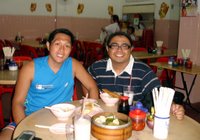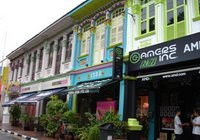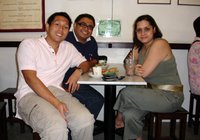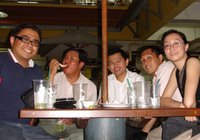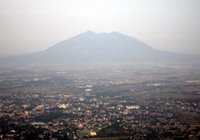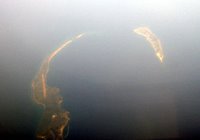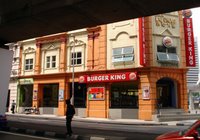 Talking about adaptive reuse, check out the photo of Burger King in a 1909 building! They do not touch the building at all! I saw a McDonald's in an old building in Singapore as well. Really nice! Attention Vigan, your biggest crime was demolishing the remains of a centuries-old convento and replacing it with a McDonald's building which most heritage people have been criticizing. Sorry to say, it does not blend with the rich heritage fabric of your historic city. You don't put a belltower replica right beside the real belltower.
Talking about adaptive reuse, check out the photo of Burger King in a 1909 building! They do not touch the building at all! I saw a McDonald's in an old building in Singapore as well. Really nice! Attention Vigan, your biggest crime was demolishing the remains of a centuries-old convento and replacing it with a McDonald's building which most heritage people have been criticizing. Sorry to say, it does not blend with the rich heritage fabric of your historic city. You don't put a belltower replica right beside the real belltower.This goes as well to the parish priest of Lingayen. Instead of demolishing that perfectly preserved convento of yours, you could have done some adaptive reuse instead. And for Mayor Lito Atienza, adaptive reuse was the best thing to do with the Jai Alai Building. The City Government demolished it and now they do not even have funds to build the proposed Hall of Justice when they could have used the Jai Alai Building for the very same purpose. Oh well!
 I got to the station and took a short subway ride to KL Sentral which was a kilometer away from the old KL Train Station. I saw the old station on the way to KL Sentral. Magnificent old building! I wonder what got into Mayor Atienza when he had most of the Paco Train Station demolished into oblivion.
I got to the station and took a short subway ride to KL Sentral which was a kilometer away from the old KL Train Station. I saw the old station on the way to KL Sentral. Magnificent old building! I wonder what got into Mayor Atienza when he had most of the Paco Train Station demolished into oblivion.Finally got to KL Sentral and went straight for the bus. An middle-aged Chinese Malaysian businessman sat beside me and he started a conversation. When he found out I was from the Philippines, he started reminiscing. He said he had wanted to visit the Philippines for the longest time. When he was in high school, the Philippines was a leader in Asia. Everyone wanted to go there. It was so well-developed. It's sad that because of political instability, the country is now at the bottom.
Tourism was so strong then. He said that today, no one hears about the Philippines anymore... attention DOT, I think this is a comment from a Malaysian who knows much about the Philippines but hasn't seen it yet. Word of mouth is the most powerful advertising tool and in order to utilize that, we have to attract the ordinary backpacker to visit the country among others.
He was well-read since he knew all our presidents from Marcos to GMA. He said that the people power thing is not giving a good image of the country. It makes investors feel that the Philippines is unstable and that anything could happen anytime. I guess one EDSA was enough for a proud moment. But the second, the third or even a fourth is just too much.
He said that people like him were very scared to invest in the Philippines. And it also has a lot to do with how the media projects the country. Attention Philippine media, he was right in saying that you have the prerogative on how to present the country. There are so many good things you can show the world and yet you chose all the negative things since that is what sells. Can we please do something constructive and productive.
In the eyes of a foreigner, the coup was bad and the fact that it was immediately crushed sent good signs abroad. Listen up GMA and the opposition, quit the bickering! If you really love our country, sit down, settle your differences and start doing your jobs right. No more family members and their cronies taking advantage of the people's money, no more unlawful arrests or human rights violations, no more street rallies and other disruptive exercisies, no more grandstanding at legislative inquiries. Stop it! While both sides are in a power struggle, Juan de la Cruz is getting poorer, his standard of living going down ever further. Sigh!
Then he said it was good that I travelling while I was young. While one is not yet committed to his family, he should try to visit the world since the knowledge one gets from travel is much more than what we get from any formal education. Once you have a family, you will no longer have any time for educational travel.
It was nice listening to his thoughts. Anyway, I arrived at the LCC-T at about 1 p.m. and had lunch at a fast food which served local food. It was another nasi lemak. Ever since that trip to Kota Kinabalu last year, it's one of the dishes I crave for especially the sambal sauce. When I get back to KL on the 17th, it's Indian food I will be looking for.
On another note, Kota Kinabalu is one of only 12 cities in Malaysia. In fact before 1994, there were only five. At least they know what a city means. Here in the Philippines, some rural municipality for some reason becomes a city only because it satisfied land area and population. Hehe! At the same time, they are merging localities globally. The opposite is happening in the Philippines since we have so many LGUs. I think we should cut the number in half!
I was quite early for check-in for the Phnom Penh flight but it's better to be early than to be left behind. On the bus, there was this American girl who was close to tears since she was already late for her flight. Low cost carriers are very strict with time and counters close exactly one hour before departure. So don't even think of being late. Hehe! Left Malaysia at about 3:30 p.m.

